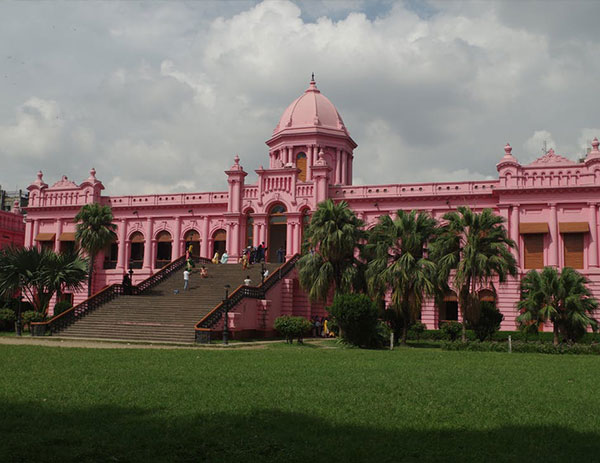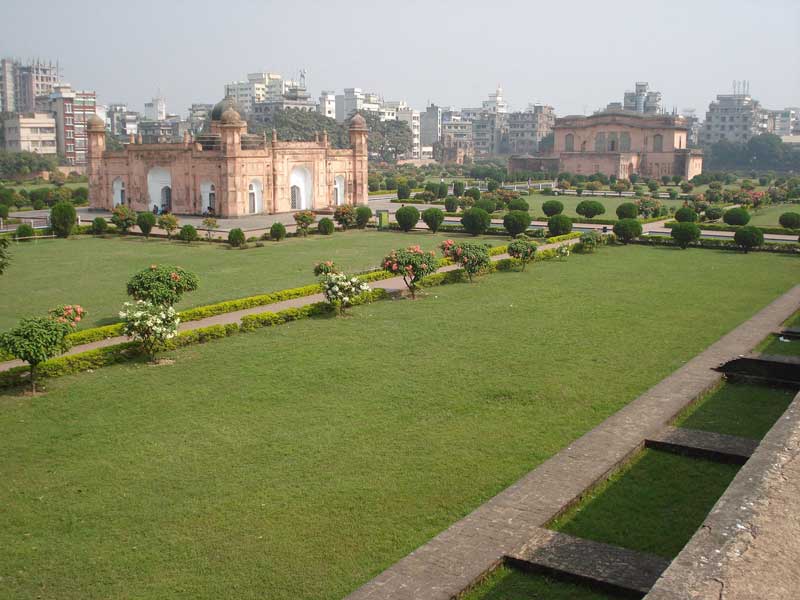 The Bangladesh Travel Guide
The Bangladesh Travel Guide
Travel Bangladesh : Dhaka Division
:: Ahsan Manjil
Built in 1872 and standing on the river Buriganga, this stately building offers the visitors a feeling of the life-style of the Nawabs of Dhaka. Sometimes known as the Pink Palace, this building now houses a splendid museum.
Basically, it was the residence of the Nawabs. Nawab Abdul Gani renovated this building in the year 1872 and named it after his son Khaza Ahasanullah.
 [Ahsan Manjil]
[Ahsan Manjil]
On the bank of river Buriganga in Dhaka the Pink majestic, Ahsan Manjil has been renovated and turned into a museum recently. It is an epitome of the nation's rich cultural heritage.
Todays renovated Ahsan Manjil a monument of immense historical beauty.
It has 31 rooms with a huge dome atop which can be seen from miles around. It now has 23 galleries in 31 rooms displaying of traits, furniture and household articles and utensils used by the Nawab.
Open 9 am- 5 pm from Saturday to Wednesday and 3-5 pm on Friday. Thursday is close.
:: Lalbagh Fort
The fort of Aurangabad, popularly known as the Lalbagh Fort, was built in 1678 AD by the then Viceroy of Bengal Prince Mohammad Azam, son of the Mughal Emperor Aurangazeb. The fort has a three storied structure with slender minarets at the South Gate. It has many hidden passages and a mosque of massive structure. Outstanding among the monuments of the Lalbagh Fort are the Tomb of Pari Bibi (Fairy lady) and Audience room and Hummam Khana (bathing place) of Nawab Shaista Khan, now housing a museum.
The fort was the scene of bloody battle during the first war of independence (1857) when 260 spays stationed here backed by the people revolted against British forces. It is one of the great historical places of Mughal era. A small museum is there in this fort where you will find the clothes and weapons of the Mughols.
Lalbagh fort is in the old town of Dhaka at Lalbagh. It is open 10 am-5 pm Sunday to Friday & Saturday is closed.
The capital city Dhaka predominantly was a city of the Mughals. In hundred years of their vigorous rule successive Governors and princely Viceroys who ruled the province, adorned it with many noble monuments in the shape of magnificent places, mosques, tombs, fortifications and 'Katras' often surrounded with beautifully laid out gardens and pavilions. Among these, few have survived the ravages of time, aggressive tropical climate of the land and vandal hands of man.
 [Lalbagh Fort - Dhaka]
[Lalbagh Fort - Dhaka]
But the finest specimen of this period is the Aurangabad Fort [commonly known as Lalbagh Fort], which indeed represents the unfulfilled dream of a Mughal Prince. It occupies the southwestern part of the old city, overlooking the Buriganga on whose northern bank it stands as a silent sentinel of the old city.
Rectangular in plan, it encloses an area of 1082' by 800' and in addition to its graceful lofty gateways on southeast and northeast corners and a subsidiary small unpretentious gateway on north, it also contains within its fortified perimeter a number of splendid monuments, surrounded by attractive garden. These are a small 3-domed mosque, the mausoleum of Bibi Pari the reputed daughter of Nawab Shaista Khan and the Hammam and Audience Hall of the Governor. The main purpose of this fort was to provide a defensive enclosure of the palatial edifices of the interior and as such was a type of palace-fortress rather than a siege fort.
:: Central Shahid Minar
Symbol of Bengali nationalism. This monument was built to commemorate the martyrs of the historic Language movement of 1952. Hundreds and thousands of people with floral wreaths and bouquet gather on 21 February every year to pay respect in a solemn atmosphere. The monument is located in the area of the University of Dhaka. The design and crafting of Shaheed Minar were done by the renowned Hamidur Rahman along with the contribution of Novera Ahmed; another mighty art figure of Bangladesh.
The tradition of Bangladesh is still lively and it will go on like this forever. “Ekushey February” is still remembered as a mourning day, and different events take place over there every year on the 21st February. Many songs are written about that day and with the respect of the history that made Bangladesh, people visit this place. It gets very crowded in the 21st February though as people from all over the country visit that place.
